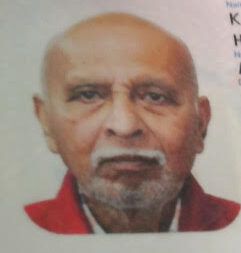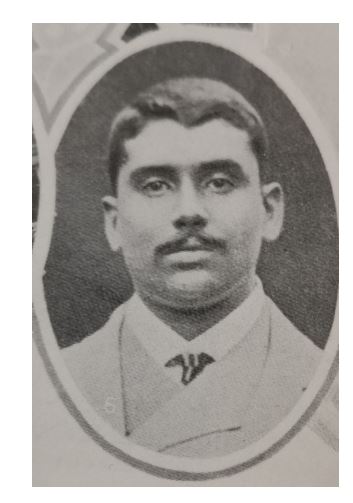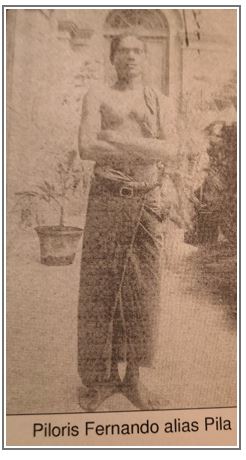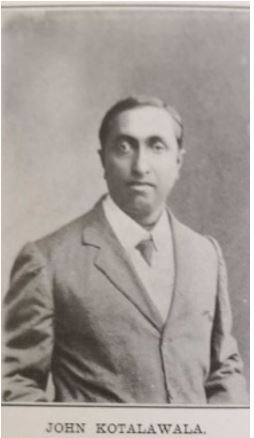WAS THE THIRD PRIME MINISTER OF CEYLON THE SON OF A MURDERER ? THE TRIAL OF JOHN KOTELAWALA (SENIOR) – By HUGH KARUNANAYAKE
 John Kotelawala (Senior) was the father of Sir John Kotelawala the third Prime Minister of independent Ceylon, who held office from 1953 to 1956. John Kotelawala (Snr) was born in 1865 in the village of Bandaragama. Having attended the village school where he learnt his English, he attended schools in Colombo and then started life as a third class constable clerk in the Ceylon Police Force in the 1880s. As a policeman he was good in detective work and his general application to his duties impressive, and was within a few years promoted to the rank of Inspector. It was then that he sought the hand of, and married Alice Attygalle, the daughter of Mudaliyar D.C.G. Attygalle of Colamunne. He resigned from the police soon after his marriage. Mudaliyar Attygalle was a man of considerable wealth, owning several coconut estates, plumbago mines, and other properties in the Kurunegala and Dodangaslanda areas. He was also a great benefactor to a number of charities. Among his many acts of philanthropy was the donation for public use, of the Kurunegala Rest House which he built entirely at his own expense. The building stands in the main street of Kurunegala to this day.
John Kotelawala (Senior) was the father of Sir John Kotelawala the third Prime Minister of independent Ceylon, who held office from 1953 to 1956. John Kotelawala (Snr) was born in 1865 in the village of Bandaragama. Having attended the village school where he learnt his English, he attended schools in Colombo and then started life as a third class constable clerk in the Ceylon Police Force in the 1880s. As a policeman he was good in detective work and his general application to his duties impressive, and was within a few years promoted to the rank of Inspector. It was then that he sought the hand of, and married Alice Attygalle, the daughter of Mudaliyar D.C.G. Attygalle of Colamunne. He resigned from the police soon after his marriage. Mudaliyar Attygalle was a man of considerable wealth, owning several coconut estates, plumbago mines, and other properties in the Kurunegala and Dodangaslanda areas. He was also a great benefactor to a number of charities. Among his many acts of philanthropy was the donation for public use, of the Kurunegala Rest House which he built entirely at his own expense. The building stands in the main street of Kurunegala to this day.
Mudaliyar Attygalles family consisted of his wife, son, and three daughters. The son, who was born in 1885, was a minor when the Mudliyar died in 1901. John Kotelawala, the Mudaliyar’s only son in law at the time of his death, took over the management of the Mudaliyar’s estate which was left to his widow by his will. By 1904, Francis, the Mudliyar’s son realizing that his brother-in-law was utilizing profits from the estate for his own benefit, applied for letters of “venia aetatis” by which the Governor of Ceylon had the power to make a major of a xminor in the eyes of the law. The letters were accordingly granted to Francis by the Governor, and he took over the management of the family properties. Kotelawala not only resisted this, but also openly showed his defiance and there was considerable friction between him and his brother-in-law. He tried various ruses to gain possession of some of the properties, but failed in all his attempts. He was particularly interested in a property which he made out to the family as a piece of abandoned plumbago land, whereas it was in fact a lucrative mine later known as the Kahatagaha mine. This turned out to be one of the largest and most lucrative plumbago mines in Sri Lanka. He tried every trick in the book to gain possession of the mine, including fraud, deceit, and threats to the family, but failed; the main obstacle being his brother in law Francis. He is said to have even threatened to commit suicide in front of his mother in law by pretending to cut his throat with a knife that he produced, to which his mother in law gently informed him that she had not the slightest objection to that, and called off his bluff. Kotelawala was a physical culturist and a pupil of the Hungarian, Eugene Sandow, and projected an image of a tough and bold person who would not tolerate opposition.
The friction between him and his in laws included an incident where he attempted to take forcible possession of a family owned mine, but was chased away by workers loyal to Francis. He had to run away and humiliatingly take refuge in a boutique in which he locked himself up in fear.That incident would have hurt his projected tough image more than the actual thrashing he may have received if he fell into the hands of the angry workers. Being a man of considerable vanity, he had been sulking and threatening dire consequences. In October 1906 John Kotelawala (snr) sailed for Japan in order to float a company called the Ceylon Trading Co, most probably to provide him with an alibi as unfolding events would reveal.
THE DECEASED – FRANCIS DIXON ATTYGALLE

Francis Attygalle was said to be a most unassuming man with an engaging disposition, and very popular with his employees. He had two sisters other than his older sister Alice Kotelawala. They were Lena and Ellen. Lena was given in marriage to Colonel TG Jayewardene brother of EW Jayewardene, father of former President J.R.Jayewardene. The younger sister Ellen later married F.R. Senanayake brother of DS Senanayake Ceylon’s First Prime Minister. There is no denying the fact that the family of the three sisters dominated politics and governments in Sri Lanka during most of the Twentieth Century. The Attygalle sisters by their marriage to the Kotelaweala- Senanayake- Jayewardene triumvirate is said to have shoe horned these “political nobodies” into “somebodies’, the upward mobility being provided by the Attygalle family wealth. The Attygalle inheritance was massive, and the three daughters brought with them substantial dowries in addition to their inheritance. By 1927 T.G. Jayewardene owned 2861 acres of tea, rubber, and coconut, Alice Kotelawala 2058 acres of rubber and coconut and Ellen Senanayake 3027 acres mainly of coconut.
Francis Attygalle attended school at Wesley College and was boarded in the home of Mr CP Dias Head Master of the school who lived in the Pettah near Price Park, which was then a quiet, residential area. Even after leaving school Francis continued to live in Mr Dias’s house making it his Colombo headquarters. On the evening of 5th December 1906 he was reclining on a chair in the verandah of Mr Dias’s home, when he was called out by a boy who wanted him to meet a man named Baron Singho who was ostensibly seeking assistance to get a job. Having dismissed the man, Francis was returning to the house when he was shot by a gun fired from a few yards away. The 22 year old Francis died two days later in hospital after making a dying deposition.
John Kotelawela returned to Ceylon by ship on the morning of 24 January 1907 and was promptly arrested by a police party headed by Mr Herbert Dowbiggin, Superintendent of Police, Colombo, who was in charge of investigations into the murder. Three persons were charged with the murder. They were Baron Singho, Singhone Perera, and John Kotelawala.
It was the case for the prosecution that as a result of family disputes, John Kotelawala had decided to destroy his brother in law Francis Attygalle. He conspired with Singhone Perera, a former police constable who served under him, to kill Atyygalle. Singhone had left the Police force at the same time as Kotelawala, and was employed as a rent collector by the latter, who also provided him accommodation in one of his houses. According to the prosecution, Singhone who was a trusted servant of Kotelawala, was paid
Rs 500 through a bogus mortgage payment as a consideration for the killing, and having arranged the killing, Kotelawala left for Japan in October 1906 to create an alibi for himself. Singhone then contacted Piloris Fernando alias Pila a 23 year old native of Wadduwa, and brought him to Colombo where he resided in Singhone’s home for some weeks prior to the murder. On November 16, Singhone arranged with Pila who was a good marksman, to purchase a gun from Walker and Sons, Pettah, under an assumed name. The gun was purchased by Pila and brought to Singhone’s house where it was concealed in a wooden box.
On the night of 5 December they went across Price Park and approached Mr Dias ‘ garden. According to Pila, who turned Crown witness in the case, Singhone asked him to wait near the gate while he went into the compound with the gun. Singhone then had Baron lure Francis out of the house and shot him. He is then said to have left the gun and the bag and hurried back to the gate where he met Pila, gave him Rs5 and asked him to go back to his village. The prosecution was based largely on Pila’s evidence as Crown Witness, and it could be presumed that his version of what transpired was tailored to protect his role in the killing. What was more likely the case was that Pila who was an expert marksman did the shooting, and was directed by Singhone to arrive at a rendezvous near the gate where he would wait to execute Pila. Unfortunately for Sighone, Pila sensing danger had not returned to him, instead walking back through a devious route to his village in Wadduwa, without meeting Singhone. The prosecution case however had to depend partly on Pila’s evidence, and it alleged that Singhne conspired with Kotelawala to murder Francis and in accordance with Pila’s evidence, Singhone did the shooting as well.
THE TRIAL
The trial in the Supreme Court commenced on 15 April 1907 before an English speaking jury consisting entirely of Europeans. The prosecution was led by Mr C.M. Fernando Senior Crown Counsel, assisted by Messrs H.J.C.Pereira, R.H.Morgan, James Van Langenberg,C Brooke Elliott, and B.W. Bawa. The accused were defended by Mr C Hayley, Eardley Norton, Thomas Thornhill, and R.L. Pereira.
A significant factor was that the defence expenses of Sighone Perera was met by John Kotelawala, a fact that was readily admitted by defence counsel. While conceding that there was no implication of guilt in such conduct, the prosecution averred that the defence of Singhone Perera had been arranged by Kotelawala even before he arrived in Ceylon from his visit to Japan, a fact which the prosecution believed pointed strongly in favour of its case.


From the evidence that was led at the trial, it was clear, regardless of who did the actual shooting, that Singhone conspired with Pila to murder Francis. Singhone however was loyal to his erstwhile master, and did not reveal anything to implicate John Kotelawala, although circumstantial evidence suggested a link between the two, working towards the common objective of destroying Attygalle. It was established by the prosecution that Kotelawala made threats to the deceased, and had a strong motive to eliminate him. It was not possible for case for the Crown to be tested by the jury, because Kotelawala committed suicide in the remand prison having consumed arsenic, after Pila’s evidence was led. He had apparently concealed the arsenic in the sleeve of his coat for over 2 months in readiness for use when necessary.
At the conclusion of the trial, Singhone Perera was convicted, and paid the supreme penalty. Baron Singho was acquitted.
THE AFTERMATH
John Kotelawala was popular with the carters and harbour workers of Colombo whose welfare he had espoused with passion. Rumours that he was poisoned by the authorities spread around the city and large crowds gathered around his home “Fellowsleigh” in Asoka Gardens, and turned volent destroying public property. The home of the Crown prosecutor CM Fernando “ Netherton ‘ in Union Place was under police protection for several weeks, until calm was restored.
John Kotelawala left behind two sons, John Lionel (later Sir John), and Justin,anda daughter Freda who later married Dr CVS Corea and whose son the late Dr Gamani Corea was an internationally renowned economist.
The trial of the accused received considerable publicity by which newspapers reported proceedings in detail, on a daily basis. In later years however, the national press in Sri Lanka appears to have thrown a blanket of silence over the case, presumably under the influence of interested persons whose political destinies may have been affected by the publicity. Consequently, not many in Sri Lanka especially during the second half of the twentieth century, were familiar with the case which was widely regarded as one of the most sensational murder trials in the country. The conspiracy of silence was so effective that even members of the legal fraternity, when referring to this case called it the “K” case, rather than the “Kotelawala “ case. It has also been rumoured that most of the copies of the book by A.L. de Witt and G.E.G. Weerasinghe entitled “The Attygalle Murder Case” (from which most of the material in this article was extracted) were destroyed by interested persons, and very few copies exist.
(This article was first published by the writer in The Ceylankan Journal of The Ceylon Society of Australia # 27 of August 2004.)







